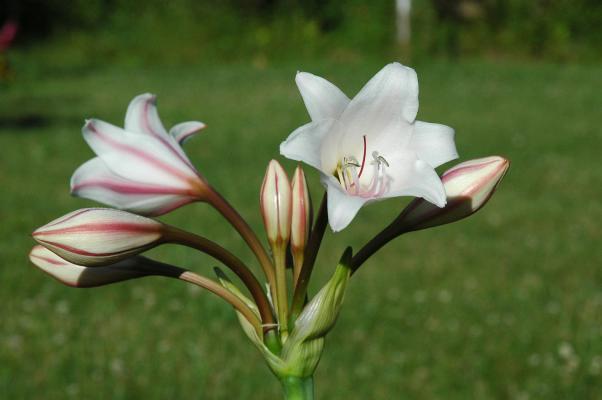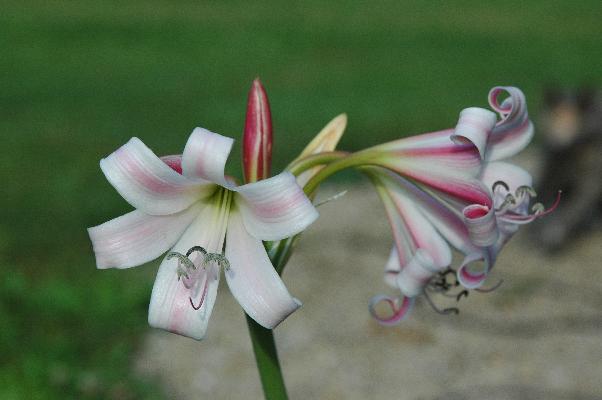I'm seeing a variety of Crinum macowanii seedlings reach bloom size now. This is clarifying something that I had previously found confusing. Namely, how are hybrids between bulbispermum and macowanii different from either parent?
The problem arose when I received three bulbs labeled "Crinum macowanii" from a South African nursery. One of the bulbs looked to me more like regular bulbispermum than it did like what I thought macowanii looked like. All three of these bulbs bloomed in June, shortly after my regular bulbispermum plants started blooming.
Then some seedlings grown from seed obtained from Silverhill Seeds in South Africa as macowanii reached bloom size, and they started blooming only in August. Furthermore, the flowers were generally flared funnels rather than the tulip shaped cups of macowanii.
Now, a new set of known [bulbispermum x macowanii] hybrids have bloomed, and two batches of seedlings from IBS (therefore probably from David Lehmiller) are blooming: one from Namibia and one from Zambia. Both bloomed early in August and both had the tulip cup shaped flowers. One that bloomed a little later had the funnel shaped flowers instead of the cupped form.
The picture below shows the essential points: The flower has some of the tulip or cupped shape, best seen viewed from the side or rear of the flower; and the anthers, underneath the cream colored pollen, are black.

Crinum (bulbispermum X macowanii)
Most macowanii and its hybrids have the older leaves with undulate margins. The leaves may or may not be glaucous (dull grey green or dull blue green).
Not all macowanii have the cupped flower form. C. macowanii #334 have the funnel shaped flowers, similar to the blooms on C. variabile, for instance. But the #334 all have black anthers and their older leaves have the typical undulate margins. Besides, the #334 bloom in August, when my Zambian and my Namibian macowanii bloom.
The [bulbispermum x macowanii] hybrids look just as much like C. macowanii as is possible, it seems to me. The main difference seems to be that they bloom between the seasons of bulbispermum (June) and macowanii (August). I have not yet tried to ascertain whether the [bulbispermum x macowanii] plants are fertile or not.
Crinum Lineare Bloom
Another clone of Crinum lineare bloomed last week. This one, #1297.A, bloomed just too late to be pollinated by #1297.C which bloomed a week ago.

Crinum lineare #1297.A
I'm starting to dig up and pot some crinums that have been in the ground outdoors for at least two winters. They are not blooming yet, and they really should have started by now; so I'll grow them each in 5-gal. pots from now on. There are a couple bulbs of Crinum [bulbispermum x graminicola] and several of C. [variabile x bulbispermum]. They should certainly be hardy enough! I want to cross all of them back on their bulbispermum parents, in the hope that I get fully fertile F2 seedlings that can be crossed, e.g., F3 = {[bulbispermum x (bulbispermum x graminicola)] X [bulbispermum x (variabile x bulbispermum)]}. Of course, I may be so old by the time that cross is made that my grandkids will have to plant the seeds!
The paradox in growing crinums outdoors in the ground here in USDA cold zone 5 is that they tend to be set back each winter as the freezing ground temperatures damage the bulbs; but in summer, the unrestricted root run they have makes them grow much faster and larger than they ever do in pots.
I've found that, regardless of the species or cross, a Crinum bulb will not survive outdoors in the ground unless it is already a pretty good sized bulb. I guess that a small bulb will freeze all the way through, and that this will kill it. A larger bulb will have the core protected from freezing by the outer layers, and can thus survive. It is clearly a very close call for any Crinum when it survives one of our winters outdoors in the ground.
In any case, letting the bulbs spend a couple winters outdoors in the ground eliminates those plants that cannot tolerate cold ground temperatures. I hope to eventually get some fully cold-hardy crinum strains from this approach to breeding.
Good gardening,
Jim